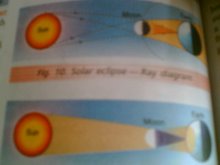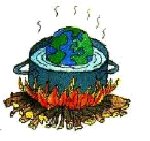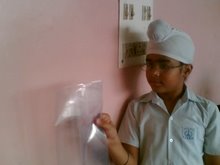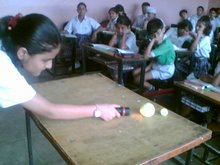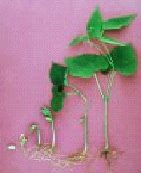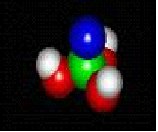Thursday, 10 April 2008
Wednesday, 9 April 2008
unusual plants
Unusual plants
Cacti are plants that live in dry areas (xeric environments). They can survive long periods of drought (a lack of water).
Anatomy and Adaptations: Cacti have many adaptations that allow them to live in dry areas; these adaptations let the plant collect water efficiently, store it for long periods of time, and conserve it (minimizing water loss from evaporation).
Cacti have a thick, hard-walled, succulent stem - when it rains, water is stored in the stem. The stems are, green, and fleshy. The inside of the stem is either spongy or hollow (depending on the cactus). A thick, waxy coating keeps the water inside the cactus from evaporating.
Many cacti have very long, fibrous roots, which absorb moisture from the soil. Some, like ball cacti, have shorter, more compact roots that absorb dew water that falls off the cactus.
Instead of leaves, most cacti have spines or scales (which are modified leaves). These spines and scales do not lose water through evaporation (unlike regular leaves, which lose a lot of water). The spines protect the cactus from predators (animals that would like to eat the cactus to obtain food and/or water). Areoles are circular clusters of spines on a cactus. Flowers bud at an areole and new stems branch from an areole.
Reproduction: Cacti are flowering plants. The flowers produce seed-bearing fruit. Many cactus species are pollinated by bats. The delicate flowers usually bloom for a short period of time in the Spring.
Many cacti can also be grown from broken-off parts of the plant (but the new plant will be genetically identical to the original plant).
Cacti are plants that live in dry areas (xeric environments). They can survive long periods of drought (a lack of water).
Anatomy and Adaptations: Cacti have many adaptations that allow them to live in dry areas; these adaptations let the plant collect water efficiently, store it for long periods of time, and conserve it (minimizing water loss from evaporation).
Cacti have a thick, hard-walled, succulent stem - when it rains, water is stored in the stem. The stems are, green, and fleshy. The inside of the stem is either spongy or hollow (depending on the cactus). A thick, waxy coating keeps the water inside the cactus from evaporating.
Many cacti have very long, fibrous roots, which absorb moisture from the soil. Some, like ball cacti, have shorter, more compact roots that absorb dew water that falls off the cactus.
Instead of leaves, most cacti have spines or scales (which are modified leaves). These spines and scales do not lose water through evaporation (unlike regular leaves, which lose a lot of water). The spines protect the cactus from predators (animals that would like to eat the cactus to obtain food and/or water). Areoles are circular clusters of spines on a cactus. Flowers bud at an areole and new stems branch from an areole.
Reproduction: Cacti are flowering plants. The flowers produce seed-bearing fruit. Many cactus species are pollinated by bats. The delicate flowers usually bloom for a short period of time in the Spring.
Many cacti can also be grown from broken-off parts of the plant (but the new plant will be genetically identical to the original plant).
Seed scienctionary 1
embryo - developing plant still inside the seed. The embryo has cotyledons (embryonic leaves), a root cap, a food source and a plumule (shoot).
hilum - the scar on a seed coat at the location where it was attached to the plant's stalk during development
micropyle - the small pore in a seed that that allows water absorption
root (hypocotyl) - the part of the stem of a sprouting plant that is above the root and below the stalk of the cotyledon (seed leaves)
seed coat (testa) - seed coat is the outer, protective layer covering the seed
seed leaf (cotyledon) - the embryonic leaf within a seed
plumule - the shoot of a embryo
hilum - the scar on a seed coat at the location where it was attached to the plant's stalk during development
micropyle - the small pore in a seed that that allows water absorption
root (hypocotyl) - the part of the stem of a sprouting plant that is above the root and below the stalk of the cotyledon (seed leaves)
seed coat (testa) - seed coat is the outer, protective layer covering the seed
seed leaf (cotyledon) - the embryonic leaf within a seed
plumule - the shoot of a embryo
Seed scienctionary 2
cotyledon - (also called seed leaves) the embryonic leaf within a seed. Dicots (plants like the bean plant above) have two cotyledons.
first true leaves - the first two leaves of the plant that emerge from the cotyledon. These leaves are the first to begin the process of photosynthesis.
hypocotyl - the part of the stem of a sprouting plant that is above the roots and below the stalk of the cotyledons.
primary root - the main, thick part of the root (and the first part to grow).
secondary root - small roots that grow from the primary root
seed coat - the outer, protective layer that covers the seed. It is shed after the bean sprouts.
first true leaves - the first two leaves of the plant that emerge from the cotyledon. These leaves are the first to begin the process of photosynthesis.
hypocotyl - the part of the stem of a sprouting plant that is above the roots and below the stalk of the cotyledons.
primary root - the main, thick part of the root (and the first part to grow).
secondary root - small roots that grow from the primary root
seed coat - the outer, protective layer that covers the seed. It is shed after the bean sprouts.
Tuesday, 8 April 2008
Healthy Eating
1. What to eat - No magic food causes weight loss and no food is inherently fattening. Eat a variety of foods from meat, legumes, dairy, grains, fruits, vegetables and small amount of fat daily. Vegetables and fruits are a great source of vitamins and minerals. Carbohydrates in fruits, milk, grains and legumes will give you quick energy for the first 2 hours while protein in milk, meat and legumes will keep you satisfied for 4 hours. The fat in meat and milk as well as fat added to foods will keep you satisfied for 6 hours.
2. Where to eat - Eliminate eating in the car, bus, train, walking, standing or on the phone. Make time to eat meals and snacks by sitting down at a table. Read about the dangers of driving and eating.
3. When to eat - Eat breakfast and two other meals each day. People who eat breakfast are less likely to snack in the evening. Eat at least every 4 to 6 hours when awake rather than waiting until your stomach starts growling.
4. How much to eat - Calories count. Choose smaller portion sizes. Forget those super sizes as they are expensive to your waistline.
5. Shopping & eating out - If you don't buy it or make it, food has a hard time finding its way into your mouth. Shop from a grocery list and after a meal when you are not hungry to limit impulse buying. In restaurants, if you aren't sure how a food is prepared ask. When your food is served, divide off what you are going to eat and take the rest home for the next meal. Just because food is presented to you at a buffet doesn't mean you have to eat or sample everything just because it is included in the price of a meal. Make food and portion sizes before you start eating.
6. Record your eating - Keep a written record of what you eat or drink, when and where to see what triggers your eating. Do you eat when you are tired, bored or upset?
7. Weigh in - Weigh yourself daily and record it. It helps keep track of your weight so that when your weight varies by more than 5 pounds you can make small eating and exercise changes before 5 pounds turns into 10 or more.
8. Pay attention & slow down - Don't get distracted by multitasking while eating. Activities like watching TV or reading takes your focus off how much you are eating and your sense of fullness. Stop when you pause while eating or sense that you are full no matter how much food is left on your plate. Eat slower and drink water with a meal. Food takes 20 minutes for a message to get from your stomach to your brain that you are full so meals should take at least 20 minutes and preferably longer. Chew each mouthful thoroughly. If you eat food that isn't on your plan, don't get down on yourself. Get immediately back on your plan rather than waiting for the next day or New Years to start again.
9. Get moving - Take a look at your daily schedule and figure out how you can walk, bike or run more. Get 30 - 60 minutes of exercise each day and wear a pedometer to keep track. Aim for 10,000 steps a day.
10. Drink water - Drink enough water so that your urine is colorless and odorless during the day. People who drink sufficient water are more likely lose weight.
2. Where to eat - Eliminate eating in the car, bus, train, walking, standing or on the phone. Make time to eat meals and snacks by sitting down at a table. Read about the dangers of driving and eating.
3. When to eat - Eat breakfast and two other meals each day. People who eat breakfast are less likely to snack in the evening. Eat at least every 4 to 6 hours when awake rather than waiting until your stomach starts growling.
4. How much to eat - Calories count. Choose smaller portion sizes. Forget those super sizes as they are expensive to your waistline.
5. Shopping & eating out - If you don't buy it or make it, food has a hard time finding its way into your mouth. Shop from a grocery list and after a meal when you are not hungry to limit impulse buying. In restaurants, if you aren't sure how a food is prepared ask. When your food is served, divide off what you are going to eat and take the rest home for the next meal. Just because food is presented to you at a buffet doesn't mean you have to eat or sample everything just because it is included in the price of a meal. Make food and portion sizes before you start eating.
6. Record your eating - Keep a written record of what you eat or drink, when and where to see what triggers your eating. Do you eat when you are tired, bored or upset?
7. Weigh in - Weigh yourself daily and record it. It helps keep track of your weight so that when your weight varies by more than 5 pounds you can make small eating and exercise changes before 5 pounds turns into 10 or more.
8. Pay attention & slow down - Don't get distracted by multitasking while eating. Activities like watching TV or reading takes your focus off how much you are eating and your sense of fullness. Stop when you pause while eating or sense that you are full no matter how much food is left on your plate. Eat slower and drink water with a meal. Food takes 20 minutes for a message to get from your stomach to your brain that you are full so meals should take at least 20 minutes and preferably longer. Chew each mouthful thoroughly. If you eat food that isn't on your plan, don't get down on yourself. Get immediately back on your plan rather than waiting for the next day or New Years to start again.
9. Get moving - Take a look at your daily schedule and figure out how you can walk, bike or run more. Get 30 - 60 minutes of exercise each day and wear a pedometer to keep track. Aim for 10,000 steps a day.
10. Drink water - Drink enough water so that your urine is colorless and odorless during the day. People who drink sufficient water are more likely lose weight.
How to Cut Down on Sugar
When you eat foods with lots of sugar you may get a lot of calories, but only a few nutrients like vitamins, minerals and fiber. You can reduce the sugar you eat and drink without giving up sweetness. Here are ways you can cut down on sugar when you shop for foods and make foods at home.
At the store, read ingredient labels to find the number and types of sugars that have been added to the food. There are many kinds of sugar that are used to make a food sweet and crisp. Look for words that end in "ose" or "ol" like dextrose, fructose, maltose, sucrose, glucose, lactose, mannitol and sorbitol. These are all forms of sugar. Syrups such as corn sweetener, sorghum syrup and high fructose syrups are sweeteners that are often added to drinks. Brown sugar, molasses and honey may be "natural" but they all give you the same calories as regular table sugar. Ingredients are listed in order by weight, from most to least. When a type of sugar or syrup is the first ingredient, you know there is more sugar in that food than any other ingredient. Some foods may contain many kinds of sugar. When they are added up, the total may be more than any other ingredient in that food.
Some breakfast cereals have 4 or more teaspoons of sugar added to each serving! When you buy unsweetened cereals you may save money and you can add your own sweetener at home. Sprinkle fresh, canned or dried fruit on your cereal to sweeten. Even sprinkling half a teaspoon of sugar or honey is better than eating a cereal that may be half sugar. Canned fruits that are packed in heavy or light syrup may give you 1 to 2 teaspoons of added sugar if you eat the syrup. You can save the sugar calories by buying fruits packed in juice. You can also drain off the syrup before you serve the fruit.
When you cook you can cut down on the amount of sugar you use, too. Sugar is needed in some baked foods like cakes to make them light and tender. If you cut out all of the sugar, the product will be tough and flat. Most recipes will come out fine if you cut down on the amount by one-quarter or one-half. Experiment with your favorite recipes to see how much sugar you can cut out and still have it look and taste good. Try new recipes that are low in sugar.
Try fruits and unsweetened fruit juices more often in meals and snacks to cut down on sugar. Fruits have natural sugars, but they also give you important vitamins and minerals. Plan to have fresh fruit in season for desserts. Use dried fruits to sweeten cereals and baked goods. Slice a banana or fresh peach instead of using jelly on a peanut butter sandwich. Make your own sodas with unsweetened fruit juice and seltzer water.
At the store, read ingredient labels to find the number and types of sugars that have been added to the food. There are many kinds of sugar that are used to make a food sweet and crisp. Look for words that end in "ose" or "ol" like dextrose, fructose, maltose, sucrose, glucose, lactose, mannitol and sorbitol. These are all forms of sugar. Syrups such as corn sweetener, sorghum syrup and high fructose syrups are sweeteners that are often added to drinks. Brown sugar, molasses and honey may be "natural" but they all give you the same calories as regular table sugar. Ingredients are listed in order by weight, from most to least. When a type of sugar or syrup is the first ingredient, you know there is more sugar in that food than any other ingredient. Some foods may contain many kinds of sugar. When they are added up, the total may be more than any other ingredient in that food.
Some breakfast cereals have 4 or more teaspoons of sugar added to each serving! When you buy unsweetened cereals you may save money and you can add your own sweetener at home. Sprinkle fresh, canned or dried fruit on your cereal to sweeten. Even sprinkling half a teaspoon of sugar or honey is better than eating a cereal that may be half sugar. Canned fruits that are packed in heavy or light syrup may give you 1 to 2 teaspoons of added sugar if you eat the syrup. You can save the sugar calories by buying fruits packed in juice. You can also drain off the syrup before you serve the fruit.
When you cook you can cut down on the amount of sugar you use, too. Sugar is needed in some baked foods like cakes to make them light and tender. If you cut out all of the sugar, the product will be tough and flat. Most recipes will come out fine if you cut down on the amount by one-quarter or one-half. Experiment with your favorite recipes to see how much sugar you can cut out and still have it look and taste good. Try new recipes that are low in sugar.
Try fruits and unsweetened fruit juices more often in meals and snacks to cut down on sugar. Fruits have natural sugars, but they also give you important vitamins and minerals. Plan to have fresh fruit in season for desserts. Use dried fruits to sweeten cereals and baked goods. Slice a banana or fresh peach instead of using jelly on a peanut butter sandwich. Make your own sodas with unsweetened fruit juice and seltzer water.
How to Cut Down on Sugar
When you eat foods with lots of sugar you may get a lot of calories, but only a few nutrients like vitamins, minerals and fiber. You can reduce the sugar you eat and drink without giving up sweetness. Here are ways you can cut down on sugar when you shop for foods and make foods at home.
At the store, read ingredient labels to find the number and types of sugars that have been added to the food. There are many kinds of sugar that are used to make a food sweet and crisp. Look for words that end in "ose" or "ol" like dextrose, fructose, maltose, sucrose, glucose, lactose, mannitol and sorbitol. These are all forms of sugar. Syrups such as corn sweetener, sorghum syrup and high fructose syrups are sweeteners that are often added to drinks. Brown sugar, molasses and honey may be "natural" but they all give you the same calories as regular table sugar. Ingredients are listed in order by weight, from most to least. When a type of sugar or syrup is the first ingredient, you know there is more sugar in that food than any other ingredient. Some foods may contain many kinds of sugar. When they are added up, the total may be more than any other ingredient in that food.
Some breakfast cereals have 4 or more teaspoons of sugar added to each serving! When you buy unsweetened cereals you may save money and you can add your own sweetener at home. Sprinkle fresh, canned or dried fruit on your cereal to sweeten. Even sprinkling half a teaspoon of sugar or honey is better than eating a cereal that may be half sugar. Canned fruits that are packed in heavy or light syrup may give you 1 to 2 teaspoons of added sugar if you eat the syrup. You can save the sugar calories by buying fruits packed in juice. You can also drain off the syrup before you serve the fruit.
When you cook you can cut down on the amount of sugar you use, too. Sugar is needed in some baked foods like cakes to make them light and tender. If you cut out all of the sugar, the product will be tough and flat. Most recipes will come out fine if you cut down on the amount by one-quarter or one-half. Experiment with your favorite recipes to see how much sugar you can cut out and still have it look and taste good. Try new recipes that are low in sugar.
Try fruits and unsweetened fruit juices more often in meals and snacks to cut down on sugar. Fruits have natural sugars, but they also give you important vitamins and minerals. Plan to have fresh fruit in season for desserts. Use dried fruits to sweeten cereals and baked goods. Slice a banana or fresh peach instead of using jelly on a peanut butter sandwich. Make your own sodas with unsweetened fruit juice and seltzer water.
At the store, read ingredient labels to find the number and types of sugars that have been added to the food. There are many kinds of sugar that are used to make a food sweet and crisp. Look for words that end in "ose" or "ol" like dextrose, fructose, maltose, sucrose, glucose, lactose, mannitol and sorbitol. These are all forms of sugar. Syrups such as corn sweetener, sorghum syrup and high fructose syrups are sweeteners that are often added to drinks. Brown sugar, molasses and honey may be "natural" but they all give you the same calories as regular table sugar. Ingredients are listed in order by weight, from most to least. When a type of sugar or syrup is the first ingredient, you know there is more sugar in that food than any other ingredient. Some foods may contain many kinds of sugar. When they are added up, the total may be more than any other ingredient in that food.
Some breakfast cereals have 4 or more teaspoons of sugar added to each serving! When you buy unsweetened cereals you may save money and you can add your own sweetener at home. Sprinkle fresh, canned or dried fruit on your cereal to sweeten. Even sprinkling half a teaspoon of sugar or honey is better than eating a cereal that may be half sugar. Canned fruits that are packed in heavy or light syrup may give you 1 to 2 teaspoons of added sugar if you eat the syrup. You can save the sugar calories by buying fruits packed in juice. You can also drain off the syrup before you serve the fruit.
When you cook you can cut down on the amount of sugar you use, too. Sugar is needed in some baked foods like cakes to make them light and tender. If you cut out all of the sugar, the product will be tough and flat. Most recipes will come out fine if you cut down on the amount by one-quarter or one-half. Experiment with your favorite recipes to see how much sugar you can cut out and still have it look and taste good. Try new recipes that are low in sugar.
Try fruits and unsweetened fruit juices more often in meals and snacks to cut down on sugar. Fruits have natural sugars, but they also give you important vitamins and minerals. Plan to have fresh fruit in season for desserts. Use dried fruits to sweeten cereals and baked goods. Slice a banana or fresh peach instead of using jelly on a peanut butter sandwich. Make your own sodas with unsweetened fruit juice and seltzer water.
Set a Goal to Lose Weight
The best way to lose weight is to set a goal for yourself and stick to it. To lose weight, you may want to make a goal to change the way you eat and the amount of exercise you get.
To succeed at making this change, you need to write a goal that is realistic, specific, and flexible. If you set a goal that is unrealistic, you may fail and give up. For example, you may think you want to lose weight by cutting out your favorite cheese that you know is high in fat. You always have this cheese with lunch or as a snack. To make your goal realistic, instead of saying you will give up having this cheese, you might say that you are going to try to have a salad or vegetable sticks, instead of the cheese. To be specific and realistic, instead of saying will give up having this cheese, you might say that you will have a salad or vegetable sticks with your lunch or snack, for the next three days. By making your goal realistic and specific, you make your goal into something you can do.
Finally, it's important to be flexible. That means, if you make a mistake or get off course, you can try again. If a friend visits you and you share some of your favorite cheese on one of the days you planned to make this change, it's all right. Start again the next day to reach your goal.
Keep your goal in mind and keep trying, you will lose weight and be able to keep it off. When you reach your goal, celebrate by going to a movie or buying a new shirt. Give yourself a reward!
To succeed at making this change, you need to write a goal that is realistic, specific, and flexible. If you set a goal that is unrealistic, you may fail and give up. For example, you may think you want to lose weight by cutting out your favorite cheese that you know is high in fat. You always have this cheese with lunch or as a snack. To make your goal realistic, instead of saying you will give up having this cheese, you might say that you are going to try to have a salad or vegetable sticks, instead of the cheese. To be specific and realistic, instead of saying will give up having this cheese, you might say that you will have a salad or vegetable sticks with your lunch or snack, for the next three days. By making your goal realistic and specific, you make your goal into something you can do.
Finally, it's important to be flexible. That means, if you make a mistake or get off course, you can try again. If a friend visits you and you share some of your favorite cheese on one of the days you planned to make this change, it's all right. Start again the next day to reach your goal.
Keep your goal in mind and keep trying, you will lose weight and be able to keep it off. When you reach your goal, celebrate by going to a movie or buying a new shirt. Give yourself a reward!
How to Lose Weight
The key to losing weight is to eat a little bit less and exercise a little bit more than you do now. Slow steady weight loss is the best. You will stay healthy and have enough energy for daily activities when you lose about one half to one pound in a week.
To lose one pound you need to cut down on or burn up 3,500 calories. It is easier to cut out 500 calories each day for 7 days to total 3,500 calories, than it is to cut out 3,500 calories in a few days. It might even be better to cut out 300 calories and exercise to burn an extra 200 calories.
The Food Guide Pyramid is a good place to see how you can cut calories. You need to know what you are eating and how much you are eating now. Then you may be able to cut down on the number of servings or the portions you eat. The Pyramid shows the number of servings and calories according to age and activity. You may not be as active as the person who needs 2,200 or 2,400 calories. So, you might want to cut down on the number of servings you eat in certain food groups. You may also want to check your serving sizes. The extra calories from bigger portion sizes can add up. Check the Food Guide Pyramid to see what counts as a serving. Try measuring the foods you eat in a day, then compare what you've eaten to the Pyramid guidelines. Take a close look at the number and serving sizes of foods you eat in the Fats, Oils and Sweets group. Do you spread a tablespoon or a teaspoon of margarine on your toast? How much oil or lard do you use when you cook? You can use less of these fats and get fewer calories.
You can also cut calories by having an extra serving of starchy foods instead of high calorie fatty foods. Try having a serving of bread, pasta, rice, fruit or vegetable instead of eating fatty foods like snack chips, pastries, processed meats or some cheeses.
Losing weight and keeping it off cannot be done by diet alone. Exercise is important, too. Thirty minutes of physical activity 5-7 days a week will help you lose weight. Walking, dancing, bicycling, swimming, and jogging are all good forms of physical activity. You don't have to give up your favorite foods or join an expensive exercise program to stay in shape. Enjoy a variety of foods and fun activities as your goal for a healthy weight.
To lose one pound you need to cut down on or burn up 3,500 calories. It is easier to cut out 500 calories each day for 7 days to total 3,500 calories, than it is to cut out 3,500 calories in a few days. It might even be better to cut out 300 calories and exercise to burn an extra 200 calories.
The Food Guide Pyramid is a good place to see how you can cut calories. You need to know what you are eating and how much you are eating now. Then you may be able to cut down on the number of servings or the portions you eat. The Pyramid shows the number of servings and calories according to age and activity. You may not be as active as the person who needs 2,200 or 2,400 calories. So, you might want to cut down on the number of servings you eat in certain food groups. You may also want to check your serving sizes. The extra calories from bigger portion sizes can add up. Check the Food Guide Pyramid to see what counts as a serving. Try measuring the foods you eat in a day, then compare what you've eaten to the Pyramid guidelines. Take a close look at the number and serving sizes of foods you eat in the Fats, Oils and Sweets group. Do you spread a tablespoon or a teaspoon of margarine on your toast? How much oil or lard do you use when you cook? You can use less of these fats and get fewer calories.
You can also cut calories by having an extra serving of starchy foods instead of high calorie fatty foods. Try having a serving of bread, pasta, rice, fruit or vegetable instead of eating fatty foods like snack chips, pastries, processed meats or some cheeses.
Losing weight and keeping it off cannot be done by diet alone. Exercise is important, too. Thirty minutes of physical activity 5-7 days a week will help you lose weight. Walking, dancing, bicycling, swimming, and jogging are all good forms of physical activity. You don't have to give up your favorite foods or join an expensive exercise program to stay in shape. Enjoy a variety of foods and fun activities as your goal for a healthy weight.
food glossary
amino acid building blocks that make up proteins.
arthritis inflammation of the joints.
calories units used to measure the energy we get from food and the energy we need to do activities.
cancer harmful tumor that spreads throughout the body.
cell tiny structure that is the basic unit of animal and plant life.
diabetes disease in which there is too much sugar in the blood because the body cannot use carbohydrate properly.
enriched food grain products like bread,rice and pasta to which nutrients like iron, thiamin, riboflavin, and niacin are added after they have been removed during processing.
enzyme a molecule made from protein that is necessary for certain chemical changes to take place in the body.
essential nutrients nutrients that you must get from foods because your body cannot make them.
fortified food a food to which nutrients have been added. Often these nutrients were not in the original, natural food.
gram a unit of weight, about 1/28 of an ounce.
hemoglobin the cells which carry oxygen through the blood stream to your muscles and organs.
high blood pressure higher than normal pressure in the arteries and capillaries (the tubes which carry blood away from the heart).
hormone a substance produced by one part of the body which is carried in the blood and affects another part of the body.
infection sickness caused by a bacteria or other substance.
intestines part of the digestive system that comes after the stomach. Many nutrients are absorbed into the blood stream through the intestine.
intoxication a sickness caused by a poison (toxin).
legumes pods produced by plants such as beans, peas, and lentils.
mental retardation slow or limited growth of the intelligence and/or behavior.
minerals naturally occurring substances such as iron, copper, magnesium, and calcium. Many minerals are needed for life and health. We get many of these minerals from the foods we eat.
nutrient a substance found in food that helps the body to work properly.
organ body structure with a specific function.
physical retardation slow or limited growth of the body.
processed food a food which has been changed during preparation. Examples of processing procedures include milling, enrichment, and addition of colors and preservatives. Depending on how a food is processed, it may be made either less or more nutritious.
red blood cells the cells which carry oxygen through the blood stream to your muscles and organs.
stroke disability caused by a blood clot in the brain. A common long term effect of stroke is partial loss of feeling and function in the face and limbs.
tissue layers of cells which form the basic structure in the body.
unit defined amount or quantity used as a standard of measurement.
vitamins natural substances found in foods that are essential to health.
arthritis inflammation of the joints.
calories units used to measure the energy we get from food and the energy we need to do activities.
cancer harmful tumor that spreads throughout the body.
cell tiny structure that is the basic unit of animal and plant life.
diabetes disease in which there is too much sugar in the blood because the body cannot use carbohydrate properly.
enriched food grain products like bread,rice and pasta to which nutrients like iron, thiamin, riboflavin, and niacin are added after they have been removed during processing.
enzyme a molecule made from protein that is necessary for certain chemical changes to take place in the body.
essential nutrients nutrients that you must get from foods because your body cannot make them.
fortified food a food to which nutrients have been added. Often these nutrients were not in the original, natural food.
gram a unit of weight, about 1/28 of an ounce.
hemoglobin the cells which carry oxygen through the blood stream to your muscles and organs.
high blood pressure higher than normal pressure in the arteries and capillaries (the tubes which carry blood away from the heart).
hormone a substance produced by one part of the body which is carried in the blood and affects another part of the body.
infection sickness caused by a bacteria or other substance.
intestines part of the digestive system that comes after the stomach. Many nutrients are absorbed into the blood stream through the intestine.
intoxication a sickness caused by a poison (toxin).
legumes pods produced by plants such as beans, peas, and lentils.
mental retardation slow or limited growth of the intelligence and/or behavior.
minerals naturally occurring substances such as iron, copper, magnesium, and calcium. Many minerals are needed for life and health. We get many of these minerals from the foods we eat.
nutrient a substance found in food that helps the body to work properly.
organ body structure with a specific function.
physical retardation slow or limited growth of the body.
processed food a food which has been changed during preparation. Examples of processing procedures include milling, enrichment, and addition of colors and preservatives. Depending on how a food is processed, it may be made either less or more nutritious.
red blood cells the cells which carry oxygen through the blood stream to your muscles and organs.
stroke disability caused by a blood clot in the brain. A common long term effect of stroke is partial loss of feeling and function in the face and limbs.
tissue layers of cells which form the basic structure in the body.
unit defined amount or quantity used as a standard of measurement.
vitamins natural substances found in foods that are essential to health.
Assignment 5
How Sweet is Your Diet?
Take a look at your eating habits for sources of added sugar.
Choose the word or phrase that best describes your diet.
How often do you ...
1. drink sugar-sweetened soft drinks, fruit drinks, fruit drinks, or punches?
a. hardly ever
b. sometimes
c. every day
2. drink coffee or tea with honey or sugar?
a. hardly ever
b. sometimes
c. every day
3. choose desserts and snacks sweetened with sugar, such as cakes, pies, cookies, candy, ice cream, or sherbet?
a. hardly ever
b. sometimes
c. every day
Take a look at your eating habits for sources of added sugar.
Choose the word or phrase that best describes your diet.
How often do you ...
1. drink sugar-sweetened soft drinks, fruit drinks, fruit drinks, or punches?
a. hardly ever
b. sometimes
c. every day
2. drink coffee or tea with honey or sugar?
a. hardly ever
b. sometimes
c. every day
3. choose desserts and snacks sweetened with sugar, such as cakes, pies, cookies, candy, ice cream, or sherbet?
a. hardly ever
b. sometimes
c. every day
Assignment 4
How's Your Sodium Intake?
The foods you choose and prepare can affect the amount of sodium in your diet. Choose the word or phrase that best answers these questions.
How often do you...
1. eat processed meats such as ham, bacon, sausage, frankfurters, or luncheon meats?
a. hardly ever
b. sometimes
c. every day
2. eat salted nuts, popcorn, pretzels, corn chips, or potato chips?
a. hardly ever
b. sometimes
c. every day
3. add salt or salty sauces to foods at the table?
a. hardly ever
b. sometimes
c. every day
4. eat TV dinners, canned soups or dehydrated soups?
a. hardly ever
b. sometimes
c. every day
The foods you choose and prepare can affect the amount of sodium in your diet. Choose the word or phrase that best answers these questions.
How often do you...
1. eat processed meats such as ham, bacon, sausage, frankfurters, or luncheon meats?
a. hardly ever
b. sometimes
c. every day
2. eat salted nuts, popcorn, pretzels, corn chips, or potato chips?
a. hardly ever
b. sometimes
c. every day
3. add salt or salty sauces to foods at the table?
a. hardly ever
b. sometimes
c. every day
4. eat TV dinners, canned soups or dehydrated soups?
a. hardly ever
b. sometimes
c. every day
Assignment 3
Assess Your Snacking Style
Think about your eating habits and patterns; what, when, where and why you eat snacks. For each question, answer "Yes" or "No" to best describe your snacking style.
WHAT foods do you usually eat as snacks or offer to your children?
1. Sweets and desserts like candies, cakes, cookies and pies.
2. Snack foods that are potato chips, corn chips, cheese curls and other "munchies."
3. Soda water,coke,pepsi
WHEN do you usually eat snacks?
4. While making meals.
5. At coffee break time.
6. Anytime.
WHERE do you usually eat snacks?
7. In front of the television.
8. Wherever I happen to be when I'm "hungry".
Why do you usually snack?
9. Foods look tempting.
10. Everyone else is eating.
11. I'm bored, frustrated, nervous or sad.
Think about your eating habits and patterns; what, when, where and why you eat snacks. For each question, answer "Yes" or "No" to best describe your snacking style.
WHAT foods do you usually eat as snacks or offer to your children?
1. Sweets and desserts like candies, cakes, cookies and pies.
2. Snack foods that are potato chips, corn chips, cheese curls and other "munchies."
3. Soda water,coke,pepsi
WHEN do you usually eat snacks?
4. While making meals.
5. At coffee break time.
6. Anytime.
WHERE do you usually eat snacks?
7. In front of the television.
8. Wherever I happen to be when I'm "hungry".
Why do you usually snack?
9. Foods look tempting.
10. Everyone else is eating.
11. I'm bored, frustrated, nervous or sad.
Assignment 2
How's Your Diet for Fat?
Do the foods you eat have more fat than you need? Choose the word or phrase that best describes your diet.
How often do you . . .
1. eat fried foods or use oil, lard, butter, or margarine when cooking?
a. hardly ever
b. sometimes
c. every day
2. eat sausage, luncheon meats, bologna, hot dogs, or bacon?
a. hardly ever
b. sometimes
c. every day
3. drink whole milk or eat hard cheeses or ice cream?
a. hardly ever
b. sometimes
c. every day
4. eat potato chips, cheese puffs, cookies, doughnuts, pies, pastries, or cakes?
a. hardly ever
b. sometimes
c. every day
Do the foods you eat have more fat than you need? Choose the word or phrase that best describes your diet.
How often do you . . .
1. eat fried foods or use oil, lard, butter, or margarine when cooking?
a. hardly ever
b. sometimes
c. every day
2. eat sausage, luncheon meats, bologna, hot dogs, or bacon?
a. hardly ever
b. sometimes
c. every day
3. drink whole milk or eat hard cheeses or ice cream?
a. hardly ever
b. sometimes
c. every day
4. eat potato chips, cheese puffs, cookies, doughnuts, pies, pastries, or cakes?
a. hardly ever
b. sometimes
c. every day
Assignment 1
How Do You Fare on Food and Fitness?
Choose "Yes" or "No" to each statement to best describe
your food and health habits.
Do you...
1. eat at least 6 servings of breads, cereals, rice, crackers, pasta or other foods made from grains each day?
2. eat foods made from whole grains, like whole-wheat bread, oatmeal, brown rice and grits?
3. eat 2 or more kinds of fruit or fruit juice each day?
4. eat 3 or more different kinds of vegetables each day?
5. eat cooked dry beans or peas 3 times a week?
6. eat a dark-green leafy vegetables such as spinach or broccoli 3 or more times week?
7. eat 2 servings of lean meat, poultry, fish or beans each day (such as skinless poultry and lean beef or pork)?
8. eat 2 servings of low fat milk, yogurt or cheese each day?
9. limit the amount of fats or oil or use lower fat alternatives as spreads or in cooking?
10. exercise for 20-30 minutes (such as walking, bicycling, or swimming) 3 or more times a week?
--------------------------------------------------------------------------------
Choose "Yes" or "No" to each statement to best describe
your food and health habits.
Do you...
1. eat at least 6 servings of breads, cereals, rice, crackers, pasta or other foods made from grains each day?
2. eat foods made from whole grains, like whole-wheat bread, oatmeal, brown rice and grits?
3. eat 2 or more kinds of fruit or fruit juice each day?
4. eat 3 or more different kinds of vegetables each day?
5. eat cooked dry beans or peas 3 times a week?
6. eat a dark-green leafy vegetables such as spinach or broccoli 3 or more times week?
7. eat 2 servings of lean meat, poultry, fish or beans each day (such as skinless poultry and lean beef or pork)?
8. eat 2 servings of low fat milk, yogurt or cheese each day?
9. limit the amount of fats or oil or use lower fat alternatives as spreads or in cooking?
10. exercise for 20-30 minutes (such as walking, bicycling, or swimming) 3 or more times a week?
--------------------------------------------------------------------------------
fats
Fats, Oils and Sweets
Fats, oils and sweets give us calories. Fats and oils like salad dressings, mayonnaise, butter, margarine and lard tend to be high in calories because of the fat they contain. Sweets like candy, soft drinks, syrups, jams, and jellies are made mostly of sugars. Most of these foods do not contain many vitamins or minerals. So they are called "empty calorie" foods.
Fats, oils and sweets are not bad foods. When we eat them along with foods like grains, fruits, vegetables, milk and meat products they are part of a healthy diet. Eating too many fats, oils or sweets can be a problem when we eat them instead of foods and nutrients we get in the other food groups.
Fats, oils and sweets add flavor and variety to our diets. We don't have to give them up. We can use less of them to help us stay fit and healthy. We can spread a smaller amount of butter, margarine or jelly on toast or muffins. We can use less fat and oil in cooking. When we cook we can cut down of some of the fats and sugars by reducing the amounts of these ingredients in the recipes we make.
Fats, oils and sweets give us calories. Fats and oils like salad dressings, mayonnaise, butter, margarine and lard tend to be high in calories because of the fat they contain. Sweets like candy, soft drinks, syrups, jams, and jellies are made mostly of sugars. Most of these foods do not contain many vitamins or minerals. So they are called "empty calorie" foods.
Fats, oils and sweets are not bad foods. When we eat them along with foods like grains, fruits, vegetables, milk and meat products they are part of a healthy diet. Eating too many fats, oils or sweets can be a problem when we eat them instead of foods and nutrients we get in the other food groups.
Fats, oils and sweets add flavor and variety to our diets. We don't have to give them up. We can use less of them to help us stay fit and healthy. We can spread a smaller amount of butter, margarine or jelly on toast or muffins. We can use less fat and oil in cooking. When we cook we can cut down of some of the fats and sugars by reducing the amounts of these ingredients in the recipes we make.
vitamins and minerals
Fruits
Fruits are important sources of vitamins and carbohydrates like fiber and sugar. They are low in calories and naturally sweet. Fruits and their juices are good sources of water, too.
Different fruits contain different vitamins, so it is important to eat a variety of fruits. Mangoes, papayas, melons and citrus fruits, like oranges and grapefruit, are high in vitamin C. Cantaloupe, apricots, peaches, and nectarines are sources of vitamin A.
Whole fruits like apples and grapes contain more fiber than fruit juices and sauces, like applesauce and grape juice. Dried fruits like figs, prunes and raisins are good sources of fiber, too. Canned fruits packed in syrup have a lot of added sugar. They are higher in calories than fresh fruits. When you shop for canned fruits, look for fruit that is packed in juice instead of syrup.
Vegetables
Vegetables are a source of important vitamins, minerals and carbohydrates. Because vegetables differ in the vitamins and minerals they contain, it is important to eat a variety of vegetables. Cabbages, plantains, peppers and leafy green vegetables like poke greens and kale are rich sources of vitamin C. Deep orange and dark green vegetables are high in vitamin A. Broccoli, spinach, collards and kale are dark green vegetables that contain calcium and iron. Cabbage family vegetables like broccoli, cauliflower, turnips and rutabagas help prevent certain cancers.
Fresh vegetables are naturally low in fat, calories and sodium. Extra fat and calories can come from cooking or other types of processing. If you add fat, oil, margarine or lard when you cook vegetables, you also add fat and calories. If you buy frozen vegetables with special sauces, you may also be adding fat and calories. You can buy frozen vegetables without special sauces and get the same nutrients as fresh vegetables. Some canned vegetables have added salt. While the salt adds flavor, it also adds extra sodium to your diet. When you shop for canned vegetables, look for vegetables with no salt added.
Fruits are important sources of vitamins and carbohydrates like fiber and sugar. They are low in calories and naturally sweet. Fruits and their juices are good sources of water, too.
Different fruits contain different vitamins, so it is important to eat a variety of fruits. Mangoes, papayas, melons and citrus fruits, like oranges and grapefruit, are high in vitamin C. Cantaloupe, apricots, peaches, and nectarines are sources of vitamin A.
Whole fruits like apples and grapes contain more fiber than fruit juices and sauces, like applesauce and grape juice. Dried fruits like figs, prunes and raisins are good sources of fiber, too. Canned fruits packed in syrup have a lot of added sugar. They are higher in calories than fresh fruits. When you shop for canned fruits, look for fruit that is packed in juice instead of syrup.
Vegetables
Vegetables are a source of important vitamins, minerals and carbohydrates. Because vegetables differ in the vitamins and minerals they contain, it is important to eat a variety of vegetables. Cabbages, plantains, peppers and leafy green vegetables like poke greens and kale are rich sources of vitamin C. Deep orange and dark green vegetables are high in vitamin A. Broccoli, spinach, collards and kale are dark green vegetables that contain calcium and iron. Cabbage family vegetables like broccoli, cauliflower, turnips and rutabagas help prevent certain cancers.
Fresh vegetables are naturally low in fat, calories and sodium. Extra fat and calories can come from cooking or other types of processing. If you add fat, oil, margarine or lard when you cook vegetables, you also add fat and calories. If you buy frozen vegetables with special sauces, you may also be adding fat and calories. You can buy frozen vegetables without special sauces and get the same nutrients as fresh vegetables. Some canned vegetables have added salt. While the salt adds flavor, it also adds extra sodium to your diet. When you shop for canned vegetables, look for vegetables with no salt added.
Calcium,proteins and vitamin D
Milk, Yogurt, and Cheese
Milk and foods made from milk are the best sources of the mineral calcium. They also provide us with vitamin A, protein and phosphorus. Fortified milk has vitamin D added to it.
The foods in this group are important because all of the nutrients work together to keep our bones strong and healthy. It may be difficult to get enough calcium unless we include these foods in our diets. We can make sure we get the milk and calcium we need by making puddings and soups with milk.
Some milk products like ice cream, cheese, whole milk and foods made from whole milk are high in fat. We can choose low-fat or skim milk products, like low-fat yogurt, skim milk and low-fat cheeses to keep the fat in our diets down.
Some people who have problems digesting milk products because of lactose (sugar) in milk. Today there are many lactose-free products to try.
Milk and foods made from milk are the best sources of the mineral calcium. They also provide us with vitamin A, protein and phosphorus. Fortified milk has vitamin D added to it.
The foods in this group are important because all of the nutrients work together to keep our bones strong and healthy. It may be difficult to get enough calcium unless we include these foods in our diets. We can make sure we get the milk and calcium we need by making puddings and soups with milk.
Some milk products like ice cream, cheese, whole milk and foods made from whole milk are high in fat. We can choose low-fat or skim milk products, like low-fat yogurt, skim milk and low-fat cheeses to keep the fat in our diets down.
Some people who have problems digesting milk products because of lactose (sugar) in milk. Today there are many lactose-free products to try.
Calcium,proteins and vitamin D
Milk, Yogurt, and Cheese
Milk and foods made from milk are the best sources of the mineral calcium. They also provide us with vitamin A, protein and phosphorus. Fortified milk has vitamin D added to it.
The foods in this group are important because all of the nutrients work together to keep our bones strong and healthy. It may be difficult to get enough calcium unless we include these foods in our diets. We can make sure we get the milk and calcium we need by making puddings and soups with milk.
Some milk products like ice cream, cheese, whole milk and foods made from whole milk are high in fat. We can choose low-fat or skim milk products, like low-fat yogurt, skim milk and low-fat cheeses to keep the fat in our diets down.
Some people who have problems digesting milk products because of lactose (sugar) in milk. Today there are many lactose-free products to try.
Milk and foods made from milk are the best sources of the mineral calcium. They also provide us with vitamin A, protein and phosphorus. Fortified milk has vitamin D added to it.
The foods in this group are important because all of the nutrients work together to keep our bones strong and healthy. It may be difficult to get enough calcium unless we include these foods in our diets. We can make sure we get the milk and calcium we need by making puddings and soups with milk.
Some milk products like ice cream, cheese, whole milk and foods made from whole milk are high in fat. We can choose low-fat or skim milk products, like low-fat yogurt, skim milk and low-fat cheeses to keep the fat in our diets down.
Some people who have problems digesting milk products because of lactose (sugar) in milk. Today there are many lactose-free products to try.
proteins
Meat, Poultry, Fish, Dry Beans, Eggs, and Nuts
Meat, poultry, fish, dry beans, eggs, and nuts are important sources of protein, iron, zinc, and B vitamins. This group includes plant foods and animal foods.
Some meats and meat products are high in fat. There are many ways to reduce the fat you get from these meats. You can choose leaner cuts like chuck, bottom round or top round of beef, pork loin or lamb shank. You can trim fat from meat before cooking and eating. You can take the skin off chicken. Many processed meats like hot dogs, sausage, pepperoni, bacon, ham and luncheon meats are high in fat and sodium. If you enjoy eating these meats, try having them less often and when you do, try eating them in smaller amounts.
Because eggs are a good source of iron and protein, they are counted as a meat serving. Most of the fat in eggs is found in the yolk. When you use the egg whites, you can cut the fat and keep the protein and vitamins you need.
Plant foods like lentils, black-eyed peas, chick peas and other dried beans and peas are inexpensive sources of protein. Unlike meats, beans are low in fat and high in fiber. Nuts and nut butters like peanuts and peanut butter are good sources of protein and iron; but they are higher in fat than other plant foods.
You can get the nutrients you need from this group without a lot of fat and without costing a lot. Many lean meats like beef chuck are also lower in cost. If you buy ground beef that is 70% fat because it is less expensive, you can still reduce the fat. Try draining the meat after you cook it or add other ingredients. Mix small amounts of meat with pasta, beans and rice to stretch your food dollar. You will get the same nutrients but it will cost you less.
Meat, poultry, fish, dry beans, eggs, and nuts are important sources of protein, iron, zinc, and B vitamins. This group includes plant foods and animal foods.
Some meats and meat products are high in fat. There are many ways to reduce the fat you get from these meats. You can choose leaner cuts like chuck, bottom round or top round of beef, pork loin or lamb shank. You can trim fat from meat before cooking and eating. You can take the skin off chicken. Many processed meats like hot dogs, sausage, pepperoni, bacon, ham and luncheon meats are high in fat and sodium. If you enjoy eating these meats, try having them less often and when you do, try eating them in smaller amounts.
Because eggs are a good source of iron and protein, they are counted as a meat serving. Most of the fat in eggs is found in the yolk. When you use the egg whites, you can cut the fat and keep the protein and vitamins you need.
Plant foods like lentils, black-eyed peas, chick peas and other dried beans and peas are inexpensive sources of protein. Unlike meats, beans are low in fat and high in fiber. Nuts and nut butters like peanuts and peanut butter are good sources of protein and iron; but they are higher in fat than other plant foods.
You can get the nutrients you need from this group without a lot of fat and without costing a lot. Many lean meats like beef chuck are also lower in cost. If you buy ground beef that is 70% fat because it is less expensive, you can still reduce the fat. Try draining the meat after you cook it or add other ingredients. Mix small amounts of meat with pasta, beans and rice to stretch your food dollar. You will get the same nutrients but it will cost you less.
Cereals: Carbohydrates
Bread, Cereal, Rice, and Pasta
Grain products like bread, cereal, rice, and pasta are good for you. They are important sources of vitamins and minerals. Breads, cereals, rice, and pasta are also good sources of carbohydrates like starch and fiber.
Many people think that starchy foods like breads, rice and pasta are fattening. They are not. But when you add fats like margarine, oil, mayonnaise, cheese sauce or gravy to them, you add many extra calories.
Whole-grain foods have more fiber than white grain foods. There are many kinds of whole-grain foods, such as oatmeal, brown rice, grits, corn tortillas and whole wheat bread. You may want to try a whole grain bread instead of white bread. Use brown rice instead of white rice or mix them together the next time you have rice.
Some breads and cereals have lots of fat and sugar added when they are manufactured. Croissants, danish, doughnuts, cake and some muffins have more fat and calories than servings of plain breads and cereals. If you enjoy sweet breads and cereals, you don't have to give them up. Try eating these foods less often or in small amounts. When you shop, read the food labels and look for breads, cereals, rice and pasta mixes that have less fat and sugar in them. You can also cut down on fat when you make rice or pasta dishes. Try using less oil, butter, or margarine than the recipe says. Sometimes you can cut the fat in half without changing the way the food tastes or looks!
Grain products like bread, cereal, rice, and pasta are good for you. They are important sources of vitamins and minerals. Breads, cereals, rice, and pasta are also good sources of carbohydrates like starch and fiber.
Many people think that starchy foods like breads, rice and pasta are fattening. They are not. But when you add fats like margarine, oil, mayonnaise, cheese sauce or gravy to them, you add many extra calories.
Whole-grain foods have more fiber than white grain foods. There are many kinds of whole-grain foods, such as oatmeal, brown rice, grits, corn tortillas and whole wheat bread. You may want to try a whole grain bread instead of white bread. Use brown rice instead of white rice or mix them together the next time you have rice.
Some breads and cereals have lots of fat and sugar added when they are manufactured. Croissants, danish, doughnuts, cake and some muffins have more fat and calories than servings of plain breads and cereals. If you enjoy sweet breads and cereals, you don't have to give them up. Try eating these foods less often or in small amounts. When you shop, read the food labels and look for breads, cereals, rice and pasta mixes that have less fat and sugar in them. You can also cut down on fat when you make rice or pasta dishes. Try using less oil, butter, or margarine than the recipe says. Sometimes you can cut the fat in half without changing the way the food tastes or looks!
Food Groups
Subscribe to:
Comments (Atom)











































